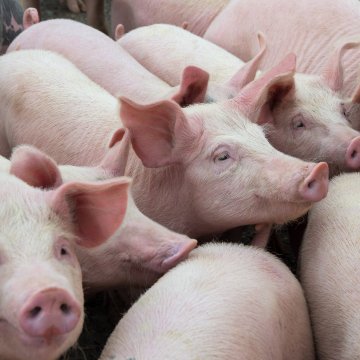Content ID
How Kansas State researchers hope to solve a billion-dollar problem in the swine industry

In July of 2021, African swine fever was detected in the Dominican Republic and Haiti, marking the first time in nearly 40 years it had made an appearance in the Western Hemisphere.
This was an indication to researchers like Megan Niederwerder, assistant professor at Kansas State University, that it was time to increase the sense of urgency for discovering methods of outbreak prevention before the virus has a chance to reach North America.
“While our primary goal is to prevent African swine fever introduction into the U.S., we have to be prepared for a swift and effective response should the virus ever enter our country,” Niederwerder says.
Niederwerder recently received a grant from the National Pork Board to lead a $513,000 research project focusing on African swine fever survival once the virus has arrived on a farm. Her research focuses on common contamination points, such as pen contamination, manure secretions, and ways the virus can be eliminated from those contamination points.
“African swine fever is very stable under certain conditions and in certain materials, so decontaminating the environment is critical to reducing the time and spread of an outbreak,” Niederwerder says. “If we can shorten the period from when the first infected animal is identified to the time when the farm is ready to repopulate and raise healthy pigs, this reduces the economic impact on pork producers.”
The earlier an outbreak can be detected, the shorter the outbreak will last and the less likely it is that the outbreak will spread. A 10-year outbreak would cost the industry about $50 billion whereas a virus lasting two years would cost the industry about $15 billion, Neiderwerder says.
“If we could shorten that to a single farm or a single year, or shorten it even more, imagine how the economic loss would be reduced,” says Niederwerder.
Though it arrived in the Western Hemisphere a few months ago, African swine fever became concerning to researchers in 2018 when the virus was identified in China. As the world's largest pork producer — producing 50% of the world’s pork — African swine fever was devastating, and spread to neighboring countries quickly.
“The other thing about this virus that makes it so dangerous for production is that it has recently emerged and spread to new areas of the world in which it has either never been diagnosed or has not been diagnosed for many decades,” Niederwerder says.
Be Aware of Clinical Signs
The study is expected to take two years to yield full results. In the meantime, Niederwerder says the best preventative steps farmers can take is to be aware of the disease's clinical signs and alert the state veterinarian if a case is suspected.
African swine fever can be challenging to identify and differentiate from other illnesses. Its most distinguishing trait is consistently a high fever, higher than other infections. Other symptoms include lethargy, reddening, and blotchiness in the perinatal areas, discoloring in the hindquarters and an inability to rise.
Though similar in symptoms to other illnesses, African swine fever is singular in its family. It is the only member of the asfarviridae virus family, which Niederwerder says is one of the factors that makes it both difficult to control and difficult to develop a vaccine for, leaving farmers to manage the virus by terminating infected animals.
“The primary way to control this virus is to eliminate pigs that have the infection; oftentimes, you also have to euthanize pigs that are even at risk for the infection,” Neiderwerder says.
Tip of the Day
When you mow in a remote area




